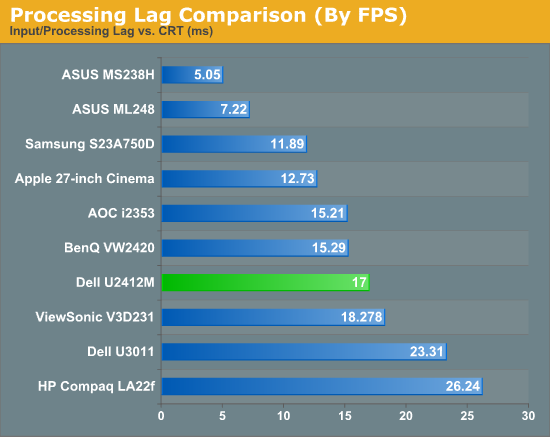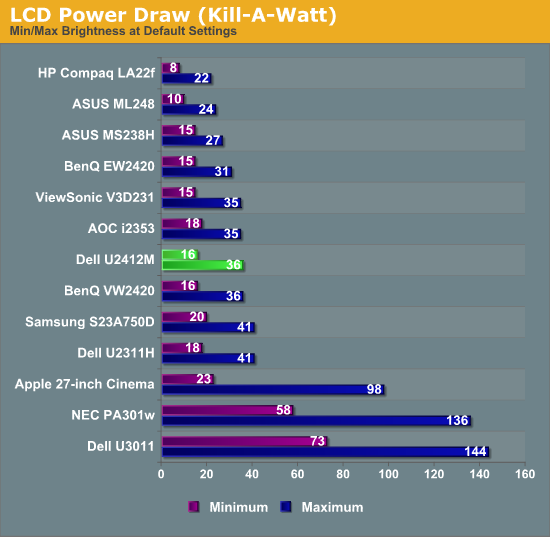Dell U2412M - 16:10 IPS without Breaking the Bank
by Chris Heinonen on February 28, 2012 9:00 AM ESTDell U2412M Input Lag and Power Use
For testing lag, I am trying a new solution to our previous testing method. I’m trying out SMTT, which is designed specifically for measuring lag in LCD displays. Using DirectX it manages to push over 1,000 frames per second to a display, allowing for millisecond accuracy instead of relying on time demos that often run well below that threshold. Using this method, we can actually determine two different values: The input lag for the LCD to initially respond, and then the total lag from when the new frame is received to when it is completely drawn and at full brightness. This last one is the overall important value, as it is what gamers would be most concerned with. It’s important to have as low an "input lag" as possible so that even if the screen isn’t fully drawn yet (the pixels will be changing over) you will be able to begin to get that feeling of responsiveness.

Here we see that the overall lag value measured OK, at 17ms. The input lag, which was also measured, was just under 2ms, which indicates that the Dell responds very quickly, and then it’s just a matter of the pixel response time. One thing to keep in mind here is that the 17ms response time is the total time from input to peak brightness, and then it takes 15ms to fall back to another value. When I actually look at the test subjectively and not objectively, you can certainly see the change in the pixel after 7-8ms of time. So I could report it as 8ms of lag, as that’s about what I think you would experience in a real world situation, but the worst case scenario seems to be 17ms, which is what I’m choosing to report as that’s the objective number.
The CRT still comes in perfect, and that’s what the LCD should aim to do; picking a number that gives a better result, even if it might be more applicable to the real world, feels like cheating. Perhaps we will get a future display technology (like OLED or CrystalLED that I saw at CES this year) that will bring us back to CRT response times, but until that happens I’m going with the objective, worst case measurement. I will report the “real world estimate” along with it, though, so you can use that for your own judgment. Please let me know what you think of this in the comments section.
I made the assumption that with a larger panel and the 300 nits of light output that the Dell would not be the most eco friendly panel I had seen. Happily I found this to not be the case. It drew just 36 watts at maximum brightness and only 16W at minimum brightness, less than even the 23” Dell U2311H from last year. I don’t know if it is more efficient LED lights, or a more transparent panel that allows more light through, but Dell did a good job keeping the power use low on the U2412M.











143 Comments
View All Comments
DarkUltra - Tuesday, February 28, 2012 - link
Maybe not $15k, but there are enthusiasts out there willing to buy sandy bridge E, high end motherboards and gtx 580 tri-sli setups. So why not a 24" 1920x1200 120Hz IPS with zero input lag?But I do agree a 30" IPS might be too expensive - until theres more demand that is. So please enlighten your next.
rscoot - Tuesday, February 28, 2012 - link
I'm not even sure if the technology exists to have zero lag 120Hz IPS displays, but when one requests the monitor equivalent of a Bugatti Veryon, one has to expect to pay the equivalent price. The economy of scale just isn't there otherwise.IceDread - Wednesday, February 29, 2012 - link
I'd pay 15k for "120Hz, 30", IPS @ 16:10, 2560:1600, no input lag", no doubt.mtoma - Wednesday, February 29, 2012 - link
I think perhaps an OLED display is bettter suited for in-door use. We don't need that much brightness, but better contrast we do. Also, why we don't see integrated webcams more often? Why a smartphone needs to have all the goodies (picture and movie recording in 720p or 1080p, Gorilla Glass, OLED).Regarding to 120 Hz (or even higher), that feature is only good when it can be disabled. Surely it's useful in games, but under no circumstances in movies. Really!
AnnonymousCoward - Saturday, March 3, 2012 - link
> Does anyone know how far from my dream we are?Very, very far. It has been 6 years since the 3007WFP came out, and nothing has superseded it. I would sure love something that steps it up: 120Hz, 2560x1600, 32", <17ms lag.
Sergio526 - Tuesday, February 28, 2012 - link
Not an extra 120 pixels, but 230,400 pixels you gain over a 1920x1080 monitor, but who's counting?Sabresiberian - Tuesday, February 28, 2012 - link
Hehe, good way to point out how much difference there really is between 16:10 and 16:9.;)
seapeople - Wednesday, February 29, 2012 - link
Or.... about 11% more pixels. For 50% more money.I swear, the math abilities of today's teenagers is going downhill fast.
colonelclaw - Tuesday, February 28, 2012 - link
Thanks for a very interesting read. As soon as this monitor was announced I was looking forward to see how it compared to other IPS monitors, and that's exactly what you did. It's exactly the kind of display I would like to fill my office with - good quality at a low price.Would you say that the NEC is the absolute best a monitor can get these days? Or is there something even better (and probably more expensive) from Eizo? I'm always interested to know what the reality is between the best and worst of any one product type, and whether or not the expense is worth it.
Oxford Guy - Tuesday, February 28, 2012 - link
"Would you say that the NEC is the absolute best a monitor can get these days? Or is there something even better (and probably more expensive) from Eizo?"Best depends on your usage model. That includes what you plan to do with it, how big your budget is, and what space you plan to use it in (lighting).
There's an HP Dreamcolor monitor with RGB LED backlighting. That's pretty interesting for color pros. But, it's not perfect.
There's another HP (27") with a constant control backlight -- which avoids PWM flicker. But, it's not perfect either. It has no onscreen display and has a very fine pixel pitch which is tough for old eyes.
Eizo makes some nice monitors, but they can be pricey.
I got a BenQ EW2420 refurb and it works fine for my usage, although I really wish it would have a constant control backlight. Flicker does fatigue my eyes after a while.